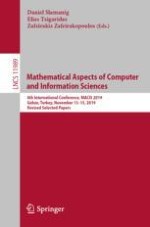2020 | Buch
Mathematical Aspects of Computer and Information Sciences
8th International Conference, MACIS 2019, Gebze, Turkey, November 13–15, 2019, Revised Selected Papers
herausgegeben von: Daniel Slamanig, Elias Tsigaridas, Zafeirakis Zafeirakopoulos
Verlag: Springer International Publishing
Buchreihe : Lecture Notes in Computer Science
